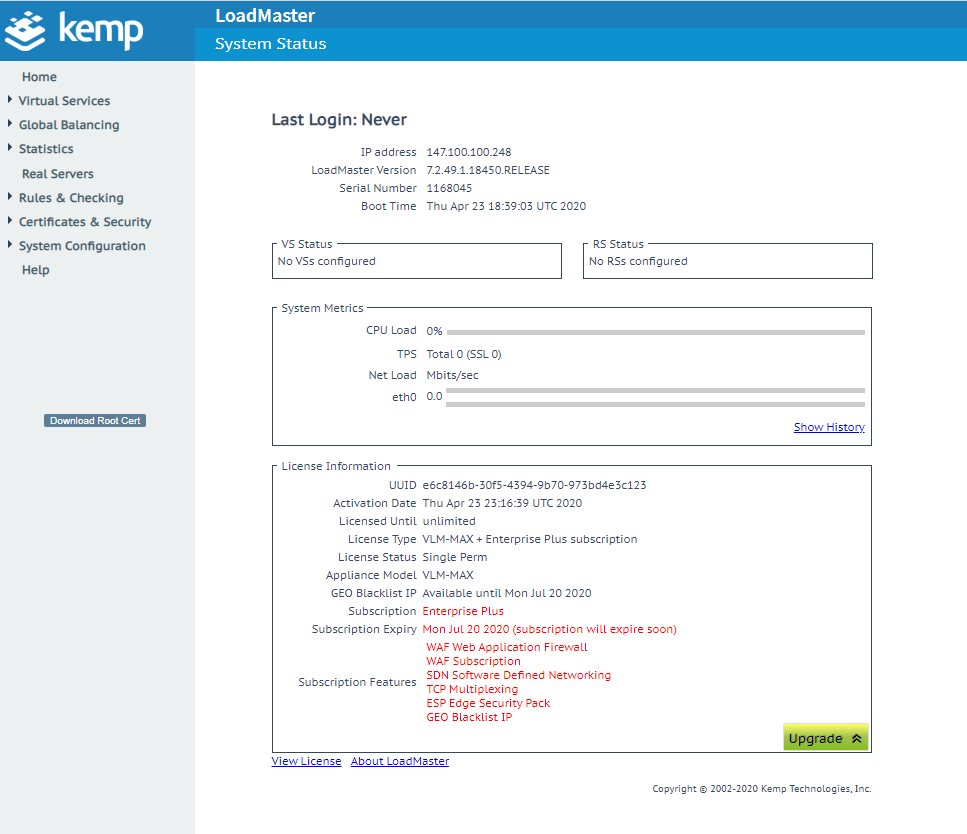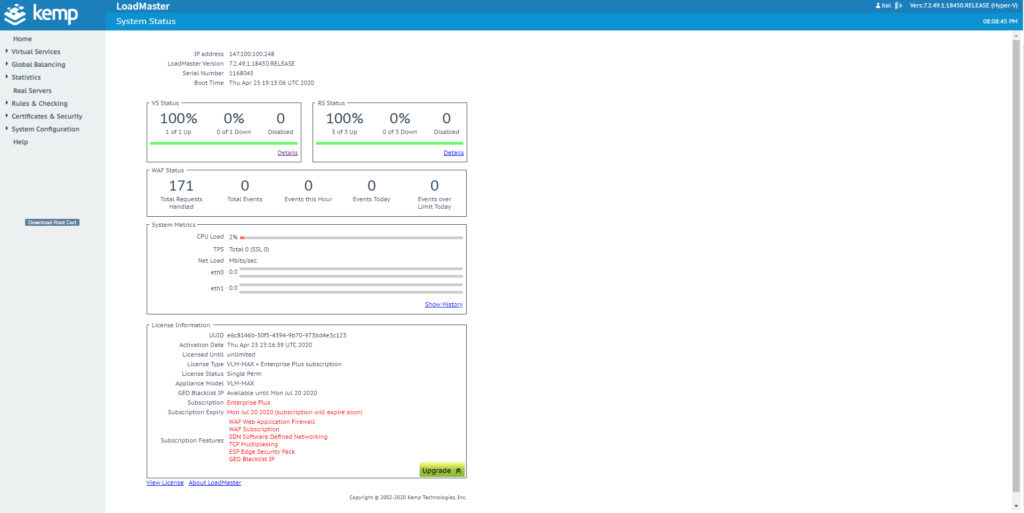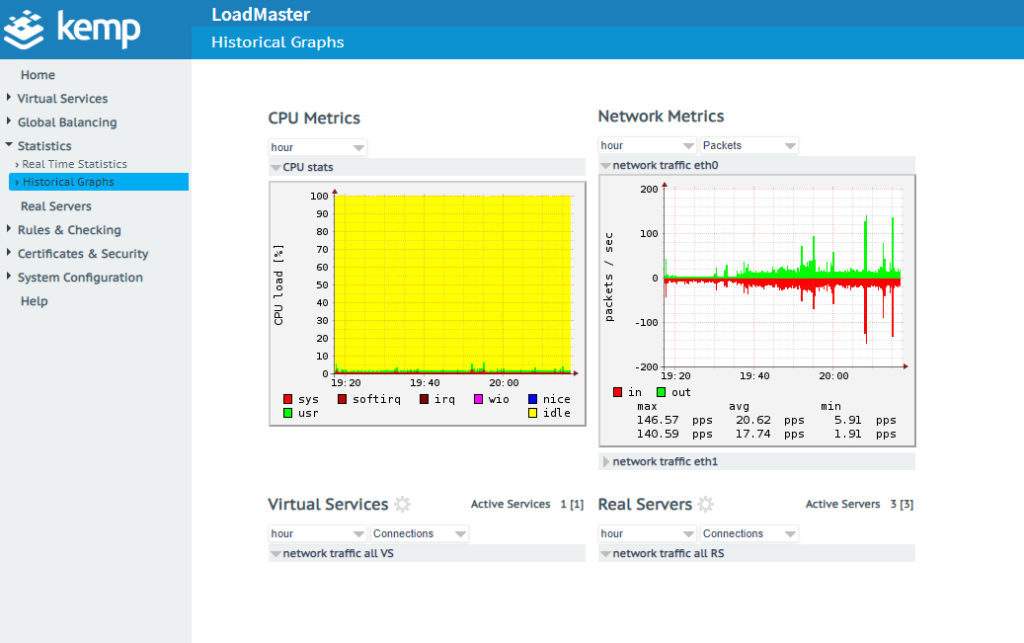Product homepage: click here
Free trial offer: click here

We can all probably agree that these are unprecedented times right now. Seemingly overnight, a huge percentage of the world’s businesses transitioned to requiring employees to work remotely. This has put an incredible strain on IT resources. That being the case, I thought that this might be a good time to review Kemp’s Virtual LoadMaster.
Virtual LoadMaster is a full-featured Layer 4 to Layer 7 (L4-L7) load balancer and Web Application Firewall. It can be configured to work with a diverse collection of workloads such as Microsoft IIS, Apache, Always On VPN, VDI, RDS, and much more. These capabilities can be helpful right now for e-commerce sites that need to deal with increased traffic, educational institutions that need to load balance the traffic generated by students accessing educational software, or corporations that need to load balance their VPN traffic.
For this review, I decided to evaluate Kemp’s VLM-MAX. It’s essentially the same as the company’s standard Virtual LoadMaster, except that it does not impose a bandwidth cap. You can find the VLM Max datasheet here.
Before I begin
Before I get started, I want to quickly clarify that although I am evaluating the VLM Max, I will be referring to my evaluation load balancer as a Virtual LoadMaster. The reason for this is because nothing that I am evaluating is specific to the VLM Max but also applies to Kemp’s Virtual LoadMaster virtual appliances.
Deployment and configuration
Kemp makes its Virtual LoadMaster available for download as a virtual appliance for several different hypervisors including Microsoft Hyper-V, VMware, KVM, and Oracle VirtualBox. It’s also available to deploy in Azure and AWS. For this review, I opted to deploy Virtual LoadMaster on a Hyper-V host.
Typically, when I write a product review, I try to deploy and configure the product without referring to the documentation. That way, I can get a feel for how intuitive the deployment process may or may not be. In this case, though, I did things a little bit differently. Since load balancers have a reputation for being tricky to configure, I decided to use the documentation. In doing so, I was pleasantly surprised to find that Kemp has created a deployment guide specifically for Hyper-V.
Following the deployment guide allowed me to deploy and perform the initial configuration of the load balancer in a matter of minutes. The deployment guide made the process relatively easy. Kemp provides a troubleshooting section at the end of the deployment guide, but I didn’t end up needing it. The image below shows what the interface looked like just before being configured.

Evaluation
Since I am evaluating the Virtual LoadMaster in a lab environment, I had to come up with a scenario that I could use for testing the load balancer. I ultimately decided to create a simple web application and then use the load balancer to distribute traffic among three frontend web servers. As I prepared to implement this configuration, I found that Kemp had already created a comprehensive guide for configuring a Virtual LoadMaster to work with Microsoft’s Internet Information Server.
Ultimately, I decided to manually configure the load balancer because I wanted to get a better feel for its interface. However, Kemp offers several downloadable templates designed for specific use cases. These templates can help to further simplify the configuration process.
While it is true that I did refer to the guide, I found the process of configuring the Virtual LoadMaster to distribute traffic among my IIS servers to be relatively straightforward, even without the aid of a template.
Incidentally, I did deviate from the guide on at least one aspect of the configuration process. Because I wanted to be able to evaluate the load balancer’s effectiveness in an environment with a limited amount of web traffic, I opted to use round-robin scheduling. That made it easy to verify that traffic was indeed being distributed to all of my web servers. You can see my configuration shown in the image below.

I found that once Virtual LoadMaster is up and running, it is easy to keep tabs on its health. Virtual LoadMaster provides simple health status indicators for any virtual services that you configure, as shown in the image below.

Virtual LoadMaster’s home screen also provides some useful information. You can see statistics regarding the total number of requests that have been handled, as well as the CPU load, server health, licensing, and more. You can see what this looks like in the next screenshot.

Virtual LoadMaster also provides a wealth of additional performance data in the form of historical graphs and real-time statistics. You can see a couple of examples in the screenshots below.


One of the things you will notice in the above image is that the Virtual LoadMaster performed exceptionally well. While I was admittedly unable to subject it to an enterprise workload, I did attempt to flood it with web requests (to the best of my ability), and in doing so I found that the Virtual LoadMaster had no trouble keeping up with the demand and only used a small fraction of the hardware resources I had allocated to it.
Additional features
As you have probably already figured out from some of the screen captures, Kemp’s Virtual LoadMaster is very feature-rich. Although I am focusing my review on the Virtual LoadMaster’s ability to balance a workload across a collection of web frontends, there are two additional features that I wanted to be sure to mention.
The first of these features is the Web Application Firewall (WAF). The reason why the WAF caught my attention is that although WAFs are relatively common, it’s somewhat unusual to see a WAF integrated into a load balancer. The WAF nicely complements the Virtual LoadMaster’s other security features, making it easy to create a layered defense for load-balanced applications.
The other feature I wanted to talk about is Kemp’s Global DNS and Traffic Management. It’s tempting to think of a load balancer as acting solely as a tool for distributing requests across a collection of servers within a datacenter (or a cloud datacenter, for that matter). However, Kemp’s GEO GSLB can distribute traffic across multiple datacenters. There are a couple of advantages to being able to do this.
First, the global distribution of traffic means that client requests are automatically directed to the datacenter that is in the closest geographic proximity to them. This helps users to receive the best possible application performance.
The other reason why the global distribution of traffic is so significant is that it can help maintain the continuity of business. If an organization experiences a failure in one of its datacenters, application traffic can be automatically redirected to an alternate datacenter, thereby ensuring that the application remains available to users.
The verdict
Whenever I write a review for this TechGenix, I always conclude the review by giving the product a star rating. These ratings range from zero to five stars, with five stars being a perfect score. After spending a considerable amount of time working with Kemp’s Virtual LoadMaster, I decided to give it a score of 4.9 stars. That is a gold star review.
Overall, I am extremely impressed with Kemp’s Virtual LoadMaster. There were several reasons for this. First and foremost, I was impressed that Kemp managed to avoid overcomplicating the administrative interface. Load balancers by their very nature are complex, but Kemp has managed to create a load balancer that is comparatively easy to use but without sacrificing features in the process. I also thought that Kemp did a great job on its documentation, which helped a lot with the product’s ease of use.
Even though I focused my evaluation on the round-robin distribution of traffic across a series of frontend web servers, there are many other features that I just did not have the editorial space to discuss. Virtual LoadMaster is capable of doing far more than just distributing traffic across web servers. For example, it can perform global server load balancing (GSLB) through Kemp’s GEO feature. It also can act as a full-featured Web Application Firewall (WAF). It can even be configured to handle SSO, multifactor authentication, web forms, and the re-encryption of encrypted web traffic. Regardless of the use-case, it is clear that Kemp has created a great product.
Rating 4.9/5


